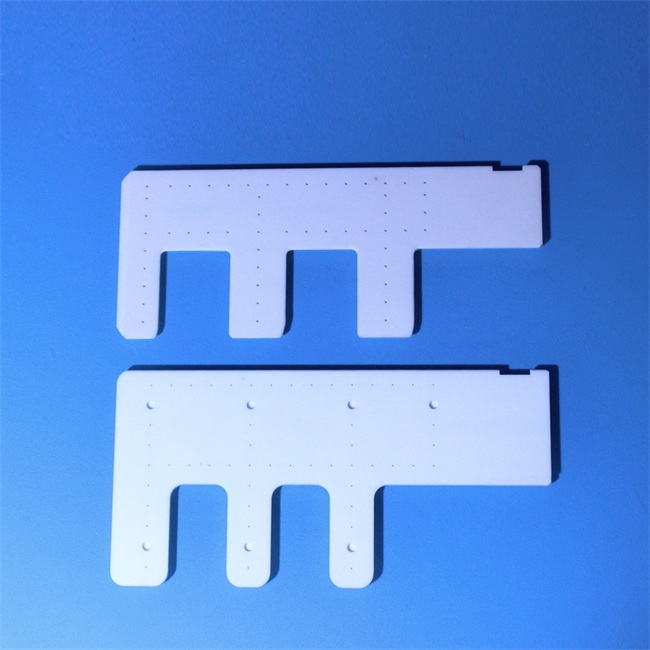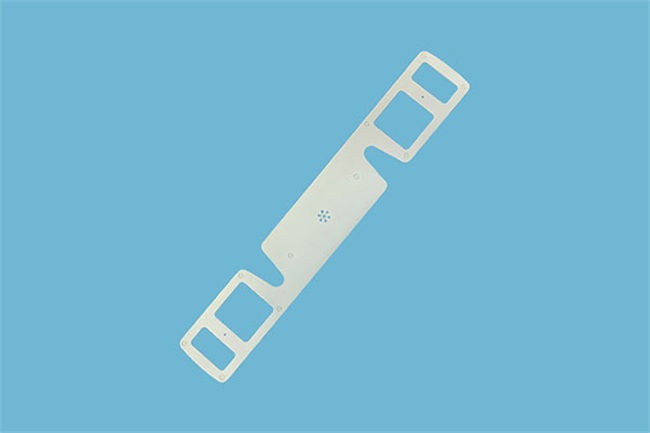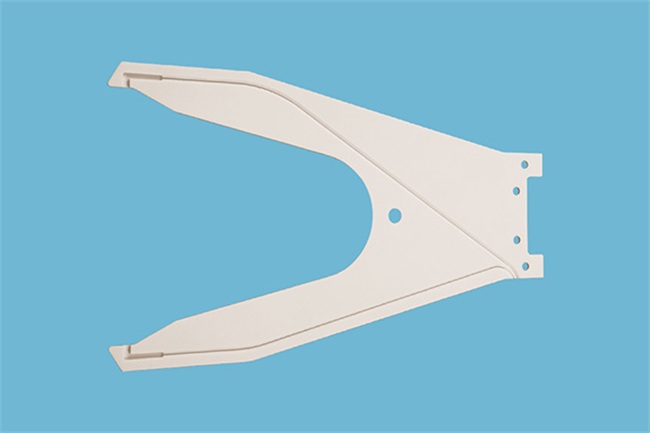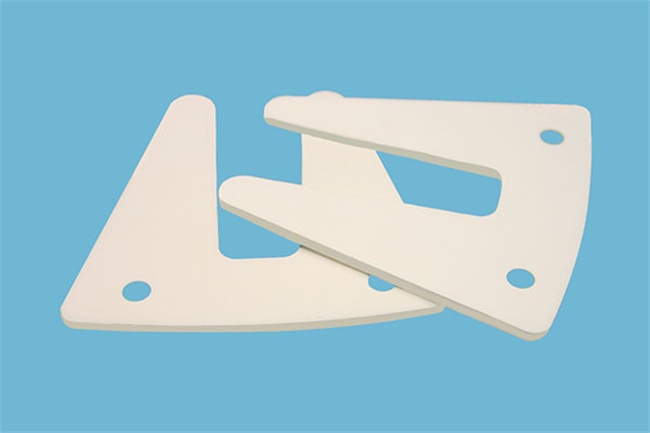The advantages of alumina ceramic arms
In modern industry, especially in high-precision fields such as semiconductors, electronics, healthcare, and lithium batteries, robotic arms have become the core components of automated production. The key to determining its performance limit and application boundaries often lies in the material of its end effector – the “arm” itself. Among numerous materials, alumina ceramic arms stand out with their excellent comprehensive performance, becoming an ideal solution to solve many pain points in traditional material applications.

What is alumina ceramic arm?
Aluminum oxide ceramic arms are industrial components made primarily from high-purity (usually 92%, 95%, or 99% or higher) aluminum oxide (Al ₂ O3) through precision molding and high-temperature sintering. It does not refer to the entire robotic arm, but rather to the critical parts that come into direct contact with the product, such as:
Mechanical Hand Claw (End effector)
Transfer Arm
Tray (Boat)
Guide Rail
These components require extremely high reliability, and alumina ceramics are one of the top materials that meet these requirements.

Detailed explanation of the core advantages of alumina ceramic arms
- Extremely high hardness and excellent wear resistance
Advantage description: The Vickers hardness of alumina ceramics is extremely high, second only to a few materials such as diamond and silicon carbide. This makes it extremely resistant to scratches and wear.
Problem solved:
Eliminate pollution: During the transportation of wafers, chips, or glass panels, metal or plastic arms may produce fine wear particles due to insufficient hardness. Once these particles fall on the product, they can cause fatal defects. Ceramic arms have almost zero wear, eliminating particle contamination from the root and greatly improving product yield rate.
Extended lifespan: In frequent high-speed reciprocating motion, the service life of ceramic arms far exceeds that of other materials, reducing the frequency of downtime for replacement and lowering long-term maintenance costs. - Excellent high temperature resistance and thermal stability
Advantage description: Alumina ceramics can work in high temperature environments above 1500 ° C for a long time, and their coefficient of thermal expansion is small, which means that they are not easily deformed or cracked in rapid cooling and heating (thermal shock) environments.
Problem solved:
Capable of high-temperature processes: Perfectly applied in equipment such as semiconductor diffusion furnaces, CVD (chemical vapor deposition), and PVD (physical vapor deposition), directly entering the high-temperature chamber for wafer picking and dropping operations, while traditional materials melt or deform in this environment.
Maintaining dimensional stability: Almost no thermal deformation occurs at high temperatures, ensuring ultra-high precision in handling and positioning, which is crucial for handling delicate and small components. - Excellent corrosion resistance and chemical inertness
Advantage description: Alumina ceramics have strong resistance to most acids, bases, salts, and organic solvents, and do not undergo chemical reactions.
Problem solved:
Resistance to chemical corrosion: In wet processes involving strong acids and bases (such as HF, HCL, NaOH) such as photovoltaic cell manufacturing, lithium battery coating, chemical or medical equipment, ceramic arms will not be corroded, ensuring long-term stability and cleanliness.
Protecting product purity: Its chemical inertness ensures that it will not react with the processed chemicals or products, avoiding secondary contamination. - High insulation
Advantage description: Aluminum oxide is an excellent insulation material with high electrical resistivity and high dielectric strength.
Problem solved:
Protecting precision circuits: When handling electronic components such as IC chips and capacitors, the risk of breakdown and damage to fragile circuits due to electrostatic discharge (ESD) is completely avoided.
Safe application: It can be used in high-voltage environments or situations that require electrical insulation to ensure the safety of equipment and operators. - Low density and moderate strength
Advantage description: The density of alumina ceramics is about one-third that of steel, but the compressive strength is very high.
Problem solved:
Realizing high-speed motion: The lightweight feature reduces the inertia and load of the robotic arm during motion, allowing the equipment to operate at higher speeds and lower energy consumption, thereby improving production efficiency.
Reduce system burden: The burden on robot joints and motors is reduced, further extending the lifespan of core moving components. - Smooth surface and anti adhesion
Advantage description: The sintered oxide ceramic has an extremely smooth surface and is not easily adhered to substances.
Problem solved:
Prevent sticking: When dealing with easily sticky substances such as resins, adhesives, and slurries, the product is less likely to stick to the arm, reducing cleaning work and defect rates.
Easy to clean: The smooth and dense surface makes it difficult for pollutants to adhere, and even if they do, they can be easily wiped clean, making it very easy to maintain.

Application scenarios
Aluminum oxide ceramic arms systematically address the core pain points of high-end manufacturing in pollution control, precision maintenance, environmental tolerance, and efficiency improvement through their comprehensive advantages of high hardness, high temperature resistance, corrosion resistance, high insulation, and lightweight.
Its main application areas include:
Semiconductor industry: wafer transfer, photolithography, etching, diffusion, CVD/PVD and other processes.
Flat Panel Display (FPD): Handling and positioning of LCD/OLED glass substrates.
Lithium battery manufacturing: handling of electrode coating, rolling, cutting and other processes.
Photovoltaic industry: production and transmission of silicon wafers.
Medical and Biotechnology: Analytical instruments, surgical robots, and scenarios that require sterility and corrosion resistance.
Precision electronics: SMT surface mount and placement of electronic components.

Choosing an alumina ceramic arm is not only about selecting a component, but also about choosing a reliable solution that ensures product quality, improves production efficiency, and reduces overall costs.
Brudeze Ceramics supplies and sells a wide range of high-quality quartz glass, including alumina ceramics, zirconia ceramics, silicon nitride ceramics, aluminum nitride ceramics, silicon carbide ceramics, boron carbide ceramics, bioceramics, machinable ceramics, etc. We can meet the customization requirements of various ceramic products.
Tags: boron carbide ceramics
PREVIOUS:What are the uses of alumina ceramic arm
NEXT:What are the advantages of silicon nitride ceramic sealing rings
CATEGORIES
LATEST NEWS
- Zirconia Ceramic Rod Custom...
- High-temperature resistance...
- What is the wear resistance...
- What is the hardness of cer...
- Aluminum oxide ceramic cust...
- What are the main aspects o...
- What are the mechanical pro...
- Thermal properties of zirco...
- What properties should be c...
- What are the mechanical pro...
